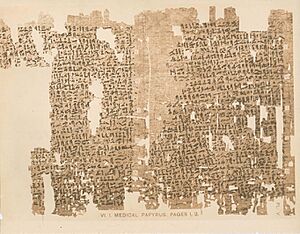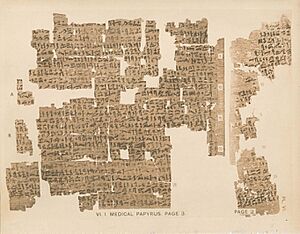Kahun Gynaecological Papyrus facts for kids
Quick facts for kids Kahun Gynaecological Papyrus |
|
|---|---|

Page 1 and part of page 2 of the Kahun Gynaecological Papyrus
|
|
| Created | c. 1825 BC |
| Discovered | 1889 Egypt |
| Discovered by | Flinders Petrie |
| Present location | London, England, United Kingdom |
The Kahun Gynaecological Papyrus (also Petrie Medical Papyrus, Kahun Medical Papyrus, Lahun Medical Papyrus, or UC32057) is the oldest known medical text in Egyptian history, dated to c. 1825 BCE, during the Twelfth Dynasty. The Papyrus addresses gynecological health concerns, pregnancy, fertility, and various treatments.
History
It was found at El Lahun (Faiyum, Egypt) by Flinders Petrie in 1889 and first translated by F. Ll. Griffith in 1893 and published in The Petrie Papyri: Hieratic Papyri from Kahun and Gurob. It is kept in the Petrie Museum of Egyptian Archaeology of the University College London. The later Berlin Papyrus and the Ramesseum Papyrus IV cover much of the same ground, often giving identical prescriptions.
The text is divided into thirty-four sections, each section dealing with a specific problem and containing diagnosis and treatment; no prognosis is suggested. Treatments are non-surgical, comprising applying medicines to the affected body part or swallowing them. The womb is seen as the source of complaints manifesting themselves in other body parts, for which its fumigation is recommended, either by oils and incense or whatever the woman smells roasting, should it cause her to smell roasting.
See also
- List of ancient Egyptian papyri
- Kahun Papyri
- History of medicine


